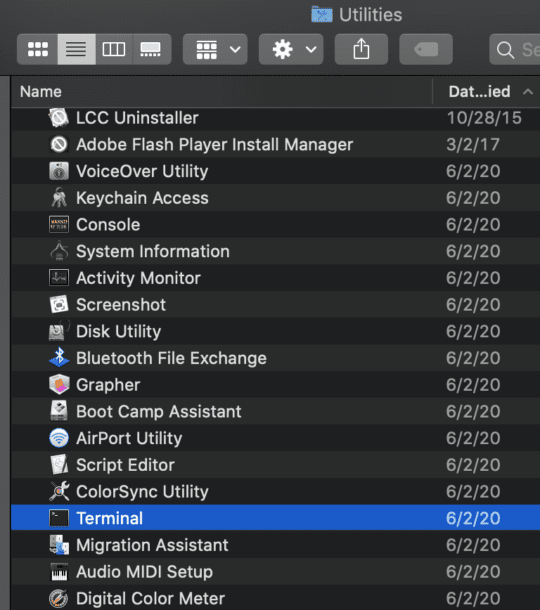Terminal is a built-in tool for macOS, but not all Mac users are aware of its usefulness. It is a powerful command-line interface and can be used to do a lot of things on your Mac device without stress. With Terminal, all you have to do is simply input a command to get the desired output on your Mac.
Contents
Setting up Terminal Commands on Mac
Before you can start using Terminal commands, you need to first locate the command prompt on your Mac device. Locate the prompt by taking the following steps:

- Open a Finder window or double click on the Macintosh HD icon.
- Find and open the Applications folder.
- After that, double click on Utilities.
- Here, you will find the Terminal. Click on Open the Terminal.
After doing this, it will take you to a window that shows the name of your PC, your username, and a dollar sign ($). All the terminal commands discussed below can be typed into the command prompt. Press the return key to go back to the command prompt.
Commands for Terminal
Mac users who do know about the built-in feature are occasionally hesitant to use Terminal. Any typo in your command could cause damage to your macOS. As long as you are careful and double-check your work, however, you should have no problem.
Here are some basic Terminal commands that you can use on your Mac device.
Check The Server Response
Ping is one of the most useful Terminal commands with which every Mac user should be familiar. This command will help you check the server response speed of domains and IP addresses. To perform this command, type into the command terminal ping [insert URL or IP address].
Keep Your Mac From Falling Asleep
Many Mac users do not know that there is a command you can use to keep your Mac awake or “caffeinated” for a certain amount of time before it goes into sleep or screensaver. To set this command type caffeinate –t 200000 into the command terminal. The command means that your Mac will stay awake for 200,000 seconds.
Show or Hide Files
Sometimes you might be looking for a file that is hidden on your Mac. You can use the following command to find their location on your system. To show all hidden files on your Mac device, type as follows: defaults Write com.apple.finder AppleShowAllFiles –bool TRUE. Directly underneath, type killall Finder.
This command will bring out all hidden files on your Mac and allow you to either edit or delete them. You can also decide to hide these files again by simply replacing the TRUE with FALSE.
Duplicate Files Between Folders on Your Mac
The can avoid the stress of copying and pasting files between folders on your Mac by merely using the duplicate files between folders command. This is achieved by using the Ditto terminal command on your Mac device. In the Terminal command prompt, type in Ditto [Original Folder] [New Folder].
Note: if you have folders in different locations with the same name, you have to include -v after Ditto to be able to achieve the right result.
Check For MacOS Updates
Your Mac device is customarily configured to check for macOS updates on a weekly basis, but a simple Terminal command can change this setting: defaults write com.apple.softwareUpdate ScheduleFrequency –int 1. Change the integer (the number seen in the command) to any number of your choice. The number represents the number of days that your device will wait before checking for updates.
You can return to the default weekly check for updates with defaults write com.apple.softwareUpdate ScheduleFrequency –int 7. With this, you can be notified of your app updates or macOS updates more frequently.
Improve Your Mac’s Screenshots
Normally, when you take screenshots on your Mac device, you will notice that it usually adds a drop shadow. These shadows can lower the quality of your screenshots. You might want to turn off these shadows by using the Terminal command defaults write com.apple.screencapture disable-shadow –bool TRUE. Underneath what you just typed, include Killall SystemUIServer. After entering this command, there should be no drop shadows added to your screenshots again.
Final Verdict
Many Mac users depend on various app preferences to have total control over their system. Terminal commands allow you to have total control without having to do this. You can use any of the terminal commands above, and many more, to customize your Mac device.










very helpful, i will try to get my head around it. thanks !
I really appreciate the help you are giving with these hints and processes tha a basic user has no knowledge about. Thank you very much.
Darrell